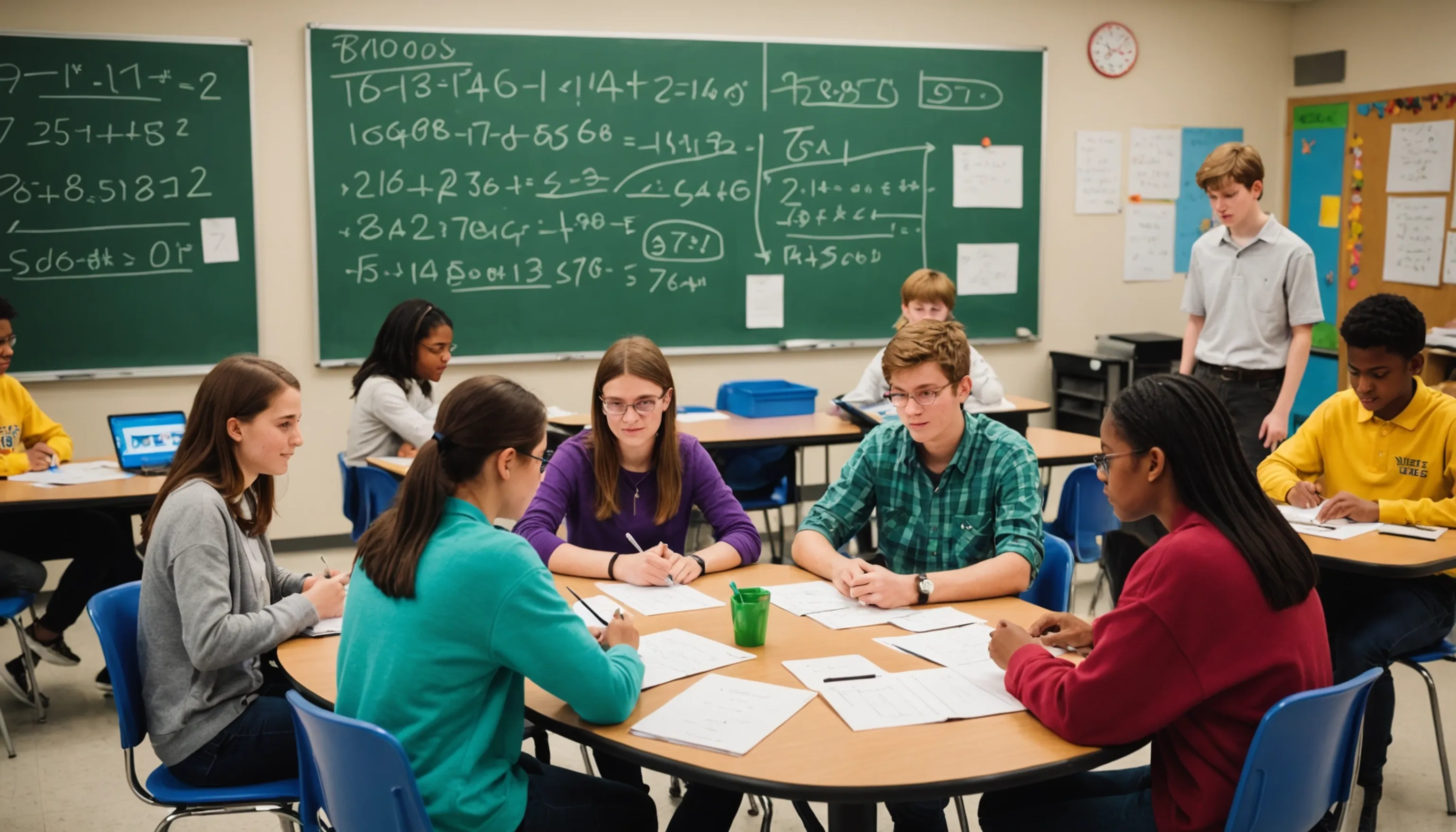Engaging Math Learning Techniques for Teens
 HvWHenry van Wagenberg
HvWHenry van Wagenberg
Engaging Math Learning Techniques for Teens
Engaging math learning techniques for teens are crucial for fostering a love for mathematics. Incorporating interactive elements such as games and technology can make learning more enjoyable. For instance, using apps that turn math into a fun challenge encourages students to practice their skills.
Real-world applications of math help teens see its relevance, making concepts more relatable. Additionally, collaborative strategies like group projects and peer teaching promote teamwork and deeper understanding. By leveraging these engaging techniques, parents and teachers can inspire teenagers to embrace math with enthusiasm.
Interactive Learning through Games
Interactive learning through games is an effective way to engage teenagers in math education. Games transform traditional learning methods into fun, dynamic experiences that capture students’ attention. This approach not only makes learning enjoyable but also enhances critical thinking and problem-solving skills.
There are various types of games that can be incorporated into math lessons:
- Board games: Classic games like Monopoly or Life can be modified to include math challenges.
- Online math games: Websites and apps offer interactive platforms where students can practice math skills while competing against peers.
- Puzzles and quizzes: Math-based puzzles stimulate logical reasoning, making them an excellent choice for individual or group activities.
Research shows that students who engage in game-based learning perform better academically. According to a study by the American Educational Research Association, game-based learning can increase students’ motivation and enhance their understanding of complex mathematical concepts.
Additionally, incorporating games into math lessons encourages collaboration. Students can work in teams to solve problems, fostering a sense of community and teamwork. This collaborative environment helps build confidence and allows students to learn from one another.
In summary, using games as a tool for interactive learning can significantly enhance math education for teenagers. By making learning enjoyable, students are more likely to develop a positive attitude toward math and improve their overall performance.
Incorporating Technology in Math Education
Incorporating technology in math education has become essential in today’s digital age. Utilizing various technological tools not only enhances the learning experience but also prepares teenagers for a tech-driven world. Interactive software, educational apps, and online resources are just a few examples of how technology can transform math learning.
One effective way to integrate technology is through the use of math apps. These apps often feature engaging games, quizzes, and tutorials that allow students to practice their skills at their own pace. For instance, apps like Khan Academy and Photomath provide interactive lessons and instant feedback, making learning more personalized.
Moreover, virtual classrooms and online platforms enable students to collaborate on math problems regardless of their location. This access to diverse resources can enhance their understanding of complex concepts. Video tutorials and online lectures also allow students to revisit challenging topics, reinforcing their learning.
Additionally, technology can facilitate real-time data analysis in mathematics. For example, using graphing software helps students visualize equations and better understand their applications. This hands-on approach fosters a deeper comprehension of mathematical principles.
Finally, embracing technology promotes digital literacy, an essential skill for the future. By integrating tech tools in math education, educators can create a more engaging, interactive, and effective learning environment that prepares students for success in a rapidly evolving world.

Real-World Applications of Math
Understanding the real-world applications of math is crucial for engaging teenagers and demonstrating the subject's relevance in everyday life. Math is not just a set of abstract concepts; it plays a significant role in various fields and everyday decisions.
One of the most relatable applications is in finance. Teens can learn to budget, calculate expenses, and understand interest rates, providing them with essential skills for managing their finances. For example, using math to determine how much to save for a car or to analyze a phone plan can enhance their financial literacy.
Another area where math is vital is in the sciences. Whether it's calculating the speed of a car in physics or measuring chemical reactions in chemistry, math is the foundation of scientific inquiry. Engaging students with experiments that require mathematical calculations can spark their interest in both math and science.
Additionally, math is extensively used in technology and engineering. Understanding concepts such as geometry and algebra is essential for students interested in pursuing careers in these fields. Activities like coding or designing structures can highlight how math is applied in innovative ways.
Furthermore, exploring topics like statistics can help students understand data analysis, which is increasingly important in a data-driven world. By discussing real-world scenarios, such as sports statistics or market trends, educators can make math more relatable and engaging for teens.
Collaborative Learning Strategies
Collaborative learning strategies are essential for fostering teamwork and communication skills among teenagers in math education. By working together on group projects, students can share their diverse perspectives and approaches to problem-solving. This collaborative environment not only enhances understanding but also builds confidence.
Strategies such as peer teaching allow students to explain concepts to one another, reinforcing their own knowledge while helping their classmates. Additionally, structured group activities, like math challenges or competitions, promote engagement and motivate students to participate actively. Ultimately, collaborative learning cultivates a supportive atmosphere that encourages students to thrive in math.
Group Projects and Peer Teaching
Group projects and peer teaching are effective methods for enhancing math education among teenagers. These strategies encourage collaboration, communication, and deeper understanding of mathematical concepts. When students work in groups, they can tackle complex problems together, combining their strengths and perspectives.
Group projects allow students to explore real-world applications of math. For instance, they can design a budget for a hypothetical event or create a statistical analysis of survey data. These projects not only make math more engaging but also demonstrate its relevance in everyday life.
Peer teaching is another powerful tool. When students explain concepts to their peers, they reinforce their own understanding and gain confidence. This method works well because students often relate better to explanations given by their classmates than by teachers. For example, a student who has mastered a particular topic can help others who are struggling, fostering a supportive learning environment.
Research shows that peer teaching can significantly improve academic performance. According to a study published in the Journal of Educational Psychology, students involved in peer teaching scored higher on assessments compared to those who learned solely through traditional methods.
Incorporating group projects and peer teaching into math lessons not only enhances comprehension but also cultivates important skills like teamwork and communication. As students collaborate, they learn to articulate their thoughts, listen to others, and approach problems from different angles, preparing them for future academic and professional success.

Math Clubs and Extracurricular Activities
Math clubs and extracurricular activities play a pivotal role in enriching the math experience for teenagers. These programs provide a platform for students to explore mathematics beyond the standard curriculum, fostering a deeper appreciation for the subject. By participating in math clubs, students can engage in various activities that challenge their problem-solving abilities and enhance their critical thinking skills.
Math clubs often organize competitions, such as math Olympiads or local contests, where students can test their skills against peers. These competitions not only promote a healthy spirit of rivalry but also encourage teamwork and collaboration. Participating in such events can boost students' confidence and ignite a passion for mathematics.
Moreover, math clubs can facilitate guest lectures and workshops led by professionals in STEM fields. Exposure to real-world applications of math can inspire students to pursue careers in mathematics, engineering, or technology. For instance, a guest speaker from a tech company might discuss how mathematical modeling is used in software development, linking classroom knowledge to industry practices.
Additionally, extracurricular activities like coding clubs or robotics teams often integrate mathematical concepts, providing practical applications that make learning engaging. These activities offer a hands-on approach to understanding math, as students design algorithms or build structures based on mathematical principles.
In summary, math clubs and extracurricular activities create a vibrant community for students to explore mathematics in a fun and engaging way, ultimately enhancing their academic journey and encouraging a lifelong love for learning.
Using Social Media for Math Engagement
Using social media for math engagement offers innovative ways to connect with teenagers and enhance their learning experience. Platforms like Instagram, TikTok, and Twitter can be leveraged to share math tips, fun challenges, and real-life applications of mathematical concepts. For example, educators can create engaging videos that explain complex ideas in a relatable manner, making math more accessible and enjoyable.
Furthermore, social media allows students to collaborate and share their work. By using hashtags related to math challenges, students can post their solutions and interact with peers, fostering a sense of community. Online math groups or forums can also provide a space for students to ask questions and receive support from others.
Ultimately, integrating social media into math education can enhance engagement, making learning more interactive and relevant to students' lives while also promoting a collaborative learning environment.
Math Challenges and Competitions
Math challenges and competitions are excellent tools for fostering enthusiasm and mastery in mathematics among teenagers. These events not only provide a platform for students to showcase their skills but also encourage critical thinking and problem-solving under pressure. By participating in math competitions, students can experience the thrill of competition while deepening their understanding of mathematical concepts.
Competitions such as math Olympiads, local contests, or online challenges allow students to tackle complex problems that require creativity and analytical skills. For instance, the American Mathematics Competitions (AMC) offers students the chance to compete at various levels, promoting a sense of achievement and recognition. Success in these competitions can enhance college applications, demonstrating a student’s dedication and proficiency in math.
Moreover, math challenges often foster collaboration and teamwork. Many competitions are held in teams, encouraging students to work together, share strategies, and learn from one another. This collaborative environment can help build friendships and foster a love for math.
Additionally, preparing for math challenges can inspire students to explore advanced topics beyond the classroom curriculum. Resources like past competition problems or online platforms can motivate students to enhance their skills and discover new areas of interest within mathematics. In summary, math challenges and competitions serve as powerful motivators for teenagers, driving engagement and passion for the subject while equipping them with valuable life skills.
Online Resources and Math Communities
Online resources and math communities provide invaluable support for teenagers seeking to enhance their math skills and engage with the subject in a collaborative manner. In today's digital age, a plethora of online platforms are available, offering everything from tutorial videos to interactive problem sets. Websites like Khan Academy and IXL provide comprehensive lessons covering various math topics, allowing students to learn at their own pace and revisit challenging concepts as needed.
Moreover, math communities such as Art of Problem Solving and Reddit’s r/math subreddit create a space for students to connect with peers who share a passion for mathematics. These platforms encourage discussion, collaboration, and the sharing of resources, fostering a supportive environment where students can ask questions and receive guidance from others.
Participating in online math forums not only helps students solve specific problems but also exposes them to diverse perspectives and problem-solving techniques. Many of these communities host virtual competitions or challenges, further motivating students to engage with math actively.
Additionally, online study groups and tutoring sessions via platforms like Zoom or Discord allow students to collaborate in real-time, enhancing their understanding through peer interaction. By leveraging these online resources and communities, teenagers can cultivate a deeper appreciation for mathematics, develop important skills, and build lasting relationships with fellow math enthusiasts.
